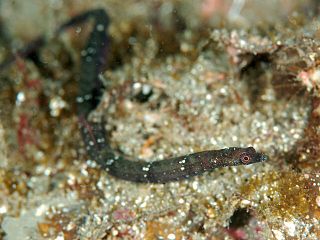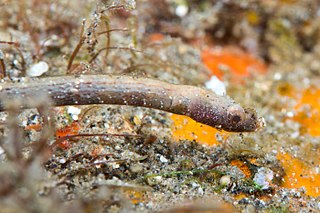
The alligator pipefish or double-ended pipefish is a species of fish in the family Syngnathidae and is the only species in the monotypic genus Syngnathoides. It is found in shallow water in the tropical and subtropical Indo-Pacific, its range extending from East Africa to northern Australia. This fish lives in habitats of seagrass and seaweed, and hides by positioning itself vertically with its head down amidst the similar-coloured fronds of vegetation. The elongated, well-camouflaged body can reach 29 cm (11 in) in length. It feeds by sucking up its prey.
Doryrhamphus janssi, commonly known as the Janss' pipefish , is a species of pipefish belonging to the family Syngnathidae.

Halicampus is a genus of pipefishes of the family Syngnathidae, containing 12 described species.

Halicampus dunckeri or also commonly known as the Duncker's pipefish or ridgenose pipefish is a species of fish in the family Syngnathidae.
Hippichthys cyanospilos, commonly known as the blue spotted pipefish or bluespeckled pipefish, is a marine fish belonging to the family Syngnathidae, native from the Indo-Pacific area.

Corythoichthys flavofasciatus, known commonly as the network pipefish, reticulate pipefish and yellow-banded pipefish, is a species of marine fish in the family Syngnathidae.

Choeroichthys brachysoma is a species of marine fish of the family Syngnathidae.
Cosmocampus howensis is a species of marine fish of the family Syngnathidae. It is found in the South Pacific from Jervis Bay to Easter Island. It lives in lagoons and on rocky reefs, where it grows to lengths of 10–12 centimetres (3.9–4.7 in). It is expected to feed on small crustaceans, similar to other pipefishes. This species is ovoviviparous, with males carrying eggs before giving birth to live young.

Booth's pipefish is a species of marine fish of the family Syngnathidae. It is found in the Western Indian Ocean, in South Africa and the Comoro Islands, and in the Western Pacific, from South Korea and Japan to the Great Barrier Reef and Tonga. It lives in rocks and coral reefs to depths of 30 metres (98 ft), where it can grow to lengths of 17.5 centimetres (6.9 in). This species is ovoviviparous, with males carrying eggs and giving birth to live young.

Halicampus brocki, the tasselled pipefish, or Brock's pipefish, is a species of marine fish of the family Syngnathidae. It is found in the Indo-Pacific, from southern Japan, Guam and the Marshall Islands to the central east and west coasts of Australia. It lives on coral and rocky reefs with algae, to depths of 45 metres (148 ft). It can grow to lengths of 12 centimetres (4.7 in), and is expected to feed on small crustaceans, similar to other pipefish. This species is ovoviviparous, with males carrying eggs and giving birth to live young.
Edmondson's pipefish is a species of marine fish of the family Syngnathidae. It is endemic to coastal waters of the Hawaiian Islands, from Oahu to Maui, where it inhabits shallow reefs, beaches and tidepools to depths of 33 metres (108 ft). Although this species' feeding habits are unknown, it is expected to feed on small crustaceans similar to other pipefishes. This species is ovoviviparous, with males carrying eggs in a brood pouch before giving birth to live young. Males may brood at 9.4 centimetres (3.7 in).
Gray's pipefish, also known as the mud pipefish or spiny pipefish is a species of marine fish of the family Syngnathidae. It is found in the Indo-Pacific in the Gulf of Aden, Sri Lanka, and from the Gulf of Thailand to Japan, the Marshall Islands, and the Great Barrier Reef. It lives to depth of 100 metres (330 ft), and planktonic juveniles have been found above depths of 3,000 metres (1.9 mi). It occurs in muddy habitats, in estuaries, and on coral reefs, where it likely feeds on small crustaceans. It can grow to lengths of 20 centimetres (7.9 in). This species is ovoviviparous, with males carrying eggs in a brood pouch before giving birth to live young.
Halicampus marquesensis is a species of fish of the family Syngnathidae. It is found primarily off of the coast of the Marquesas Islands, in French Polynesia, although other unconfirmed specimens have been reported in Fiji and Papua New Guinea. In inhabits sandy and rubble habitats from depths of 21–35 metres (69–115 ft), where it can grow to lengths of 7 centimetres (2.8 in). It likely feeds on small crustaceans, similar to other pipefish. This species is ovoviviparous, with males carrying eggs in a brood pouch before giving birth to live young.

The Samoan pipefish, or brown pipefish, is a species of marine fish of the family Syngnathidae. It is found in the Indo-Pacific, from the Red Sea, to Sodwana Bay, to Taiwan, the Marshall Islands, and Samoa, where it inhabits tidepools and coral and rocky reefs to depths of 15 metres (49 ft). It is a solitary species with cryptic habits and is rarely observed. It is likely to feed on small crustaceans, and can grow to lengths of 14 centimetres (5.5 in). This species is ovoviviparous, with males carrying the fertilised eggs in a brood pouch, the folds of which fall well short of the centre of the egg-filled pouch, eventually giving birth to live young.
The glittering pipefish is a species of marine coastal fish of the family Syngnathidae. It is found in the Western Pacific, from Viet Nam to Fiji and from the Ryukyu Islands to New Caledonia, where it inhabits corals, sand and reef flats to depths of 20 metres (66 ft).< It can grow to lengths of 7.3 centimetres (2.9 in), and is expected to feed on small crustaceans, similar to other pipefishes. It is secretive and rarely observed. This species is ovoviviparous, with males carrying eggs and giving birth to live young.
The Zavora pipefish is a species of marine fish of the family Syngnathidae. It is only known from three specimens found in the Western Indian Ocean, one from Zavora, Mozambique and two from Sur, Oman. Little is known about its habitat or feeding habits, but they are expected to feed on small crustaceans similar to other pipefish. It can grow to at least 10 centimetres (3.9 in) in length. This species is ovoviviparous, with males carrying eggs and giving birth to live young.

Hippichthys heptagonus, the belly pipefish, is a species of freshwater pipefish of the family Syngnathidae. It is found from Kenya and South Africa to the Solomon Islands, and from southern Japan to New South Wales. It is a demersal species, living in the lower parts of rivers and streams, estuary habitats such as mangroves and tidal creeks, and occasionally in large lakes. It feeds on small crustaceans, such as copepods and cladocerans, as well as dipteran and ephemopteran larvae. It can grow to lengths of 15 centimetres (5.9 in). This species is ovoviviparous, with females depositing eggs on the males, who in turn give birth to live young several weeks later. Males may brood at 6.5–7.5 centimetres (2.6–3.0 in).
The short-keel pipefish is a species of fish of the family Syngnathidae. It is known from Darwin to the Torres Strait and southern Papua New Guinea. It lives in coastal fresh and brackish habitats, such as mudflats, mangroves, gravel, sandy and rocky habitats, and coral and shell rubble. It can grow to lengths of 12 centimetres (4.7 in). It is expected to feed on small crustaceans such as copepods, shrimps and mysids, similar to other pipefish. This species is ovoviviparous, with males carrying eggs in a brood pouch before giving birth to live young. Males may brood at 7.8 centimetres (3.1 in).

The beady pipefish is a species of pipefish of the family Syngnathidae. It is found in the Indo-West Pacific, from the western Persian Gulf, to the north central Indian Ocean, to Japan and Australia. It lives in the lower parts of streams and rivers, estuarine habitats such as seagrass beds and mangroves, and shallow inshore habitats, where it can grow to lengths of 16–18 centimetres (6.3–7.1 in). It is expected to feed on small crustaceans, similar to other pipefish. This species is ovoviviparous, with males carrying eggs in a brood pouch before giving birth to live young. Average brood size is 177.
Hippichthys spicifer, commonly known as bellybarred pipefish, banded freshwater pipefish, or blue spotted pipefish, is a species of pipefish of the family Syngnathidae. It is found in the Indo-Pacific, from the Red Sea and East Africa to Sri Lanka and Samoa. It lives in shallow coastal and estuarine habitats such as mangroves, tidal creeks, and the lower reaches of rivers, where it can grow to lengths of 18 centimetres (7.1 in). It is expected to feed on small crustaceans and mosquito larvae. This species is ovoviviparous, with males brooding eggs in a brood pouch before giving birth to live young. It is reproductively active all year, with males and females reaching sexual maturity at 10.8 and 10 centimetres respectively. Brood size can vary significantly, from 114 to 1764, with an average of 604.4 plus or minus 322.8.









